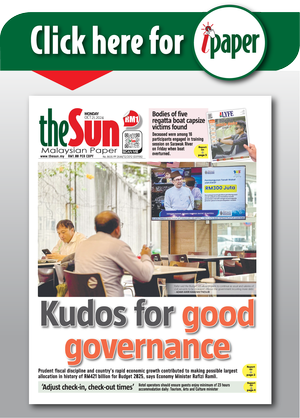OVER centuries, taxation has proven to be an effective tool to influence behaviour. This can be witnessed in personal reliefs being an effective “carrot” to promote reading habits or saving in SSPN.
Over the years, Malaysian tax policymakers have also used taxation as a tool to encourage ESG adoption among industry players.
The carrots
One of the examples of a carrot that encourages ESG-friendly practice in Malaysia is the double deduction for remuneration of disabled workers. This means that employers who employ disabled workers are given a tax deduction amount to double the remuneration paid.
Say the remuneration is RM4,000, the employer gets a tax deduction of RM8,000 and, at the tax rate of 24%, there’s RM1,920 of tax savings. In other words, about half (48% to be exact) of the remuneration is ‘subsidised’ by the government by way of tax forgone.
Double deduction for disabled workers’ remuneration was introduced in 1982 – well before ESG emerged as a buzzword. Nevertheless, even today we can witness the incentive being effective in influencing corporations to hire in a more inclusive fashion in line with the spirits of the ‘S’ in ESG, i.e. Social factors.
Over the years, the tax incentive to promote DEI agenda in hiring has also been expanded to include double deduction for remuneration of senior citizens, ex-convicts, parolees, supervised persons and ex-drug dependents. Likewise, there are tax incentives to encourage women returning to work after a career break.
As for the ‘E’ being the initial of ESG, there are many tax incentives and reliefs to promote environmentally friendly behaviour such as solar panel, EV vehicles, Carbon Capture, Utilisation & Storage (CCUS) and even food waste composting machines for household use.
As for the letter ‘G’ which represents Governance, there is tax deduction up to RM50,000 for costs related to tax corporate governance framework (TCGF). The limit for this deduction is shared with a few expenses, namely cost of ESG reporting, cost of e-Invoicing implementation and cost of preparing transfer pricing documentation.
The incentives and reliefs listed above may be dubbed as ‘carrots’ to promote ESG-friendly behaviour.
The sticks
Incentives and reliefs are not the only tax instruments that can be used to influence behaviour. Tax policy may be deployed as a ‘carrot’ to encourage certain desired behaviour or a ‘stick’ to discourage certain undesired behaviour.
Even when used as a ‘stick’, taxation is not as harsh as non-fiscal measures. To put it simply, tariffs discourage free-trade but are less-harmful than a complete trade ban such as an embargo or sanction.
Another important example would be the case of plastic. Following the widespread awareness on the environmental damages of single-use plastics, many jurisdictions such in the EU and UK has implemented a Plastic Packaging Tax (PPT) in recent years. PPT helps to close the price arbitrage between recycled plastic and virgin plastic (the former is more expensive, and PPT does not apply on packaging that use >30% recycled plastic).
PPT is vital in influencing industry behaviour but is certainly less strict than a complete ban of the use virgin plastic in packaging – as proposed by EU for introduction by 2030.
One could argue that where a complete ban of something is contemplated, a tax measure must at least be a prelude (if not an alternative) for such an action. Taxation is, at the very least, an important stepping stone (in many cases, taxation itself could achieve the desired behavioural change).
For the case of Malaysia, we neither have a ban on plastic packaging nor a PPT because it is a well-established practice to first offer carrots before reaching out to the sticks. In this regard, Malaysia is presently offering tax incentives for AI-driven reverse-vending machine to promote the use of recycled plastics. It remains to be seen if carrots are sufficient to move the needle in this case.
For decades Malaysia has in place excise duty on motor vehicles (particularly those that use combustion engines). This policy is directly linked to the ‘E’ element, but the ‘S’ element is also present given the general sentiment to link the overall [un]employment levels within a country/region with the automotive assembly plants therein.
Excise duty on tobacco and alcohol products is aimed to discourage unhealthy consumption of these products – and is directly linked to the ‘S’ element. More recently, Sugar Sweetened Beverage (SSB) is added to the list of goods subjected to excise.
Next, carbon tax is planned to be implemented for iron, steel and energy sectors effective from the year 2026. The exact date is not clear, but it’s anticipated to be consistent with EU’s CBAM definitive regime which would be effective 1st Jan 2026.
Getting the sequence right
To achieve ESG goal within any nation or organisation, I would argue the sequence is paramount. First, awareness (along with cohesive framework). Second, offer carrots (e.g. incentives) to encourage adoption. Third, implement sticks (e.g. new taxes) to encourage the late adopters to buckle up. And finally, a complete ban where appropriate (should be limited cases where the damage is extreme).
In the sequence above, both 2nd and 3rd phase involve a fiscal measure such as tax incentives or new taxes.
My take on the overall approach
It is vital for taxation policy to be not viewed as a pure fiscal measure but also an important tool to prepare the industry and public towards ESG-adoption.
It is useful to earmark any tax revenue from ESG-driven taxes to promote causes that avoid the unsustainable outcome which triggers the taxation at the first place. Idealistically speaking, the ultimate goal of introducing ESG-driven tax should be to collect zero tax by achieving the ESG-aspirations.
For example, excise duty from SSB should be spent to spread awareness of dangers of excessive sugar intake. Hence, as the society attains the awareness and readiness, the tax loss would not be viewed as a loss of tax revenue, but a reduction in earmarked revenue which corresponds to lower spending needs on the same cause.
Such an approach potentially also involves legislative change as the present legal framework requirements all tax revenue to be in the Federal Consolidated Fund, and the spendings from thereon is based on discretion exercised during the budgetary process.
ESG-driven tax initiatives are not just fiscal policies, but important measures that encourage adoption of sustainable practices among industry players and public at large. A cohesive and transparent framework is essential to achieve the intended outcome.
Thenesh Kannaa is the executive director of TRATAX Sdn Bhd, APAC international tax lead of WTS Global, chair of CTIM’s Technical Committee on Tax Policy, member of ACCA’s ESG Task Force & expert panel on taxation, and member of International Fiscal Association’s exco for Malaysia. Views expressed are his own.









